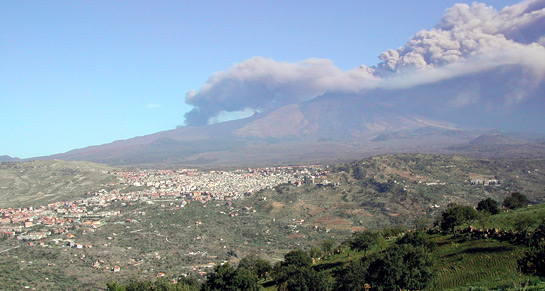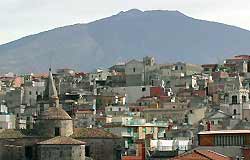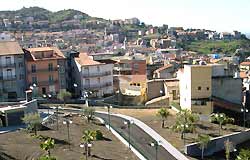 The town center, with narrow, Arabic-like streets, lays to a medium sea-level height of 800 meters, on the northwest side of mount Etna. Its altitude goes from 600 meters of the lowest point (new Sciarotta district) to 940 of the SS. Cristo zone. The town center, with narrow, Arabic-like streets, lays to a medium sea-level height of 800 meters, on the northwest side of mount Etna. Its altitude goes from 600 meters of the lowest point (new Sciarotta district) to 940 of the SS. Cristo zone. This is how the son of illustrious Brontese Giuseppe Cimbali describes the environment of the country ("Nicola Spedalieri", 1888, Città di Castello): «Has the horrid part and the pleasant part, the tender part and the epic part, in the same time. Here and there is lapped, or rather crowned, crowned sadly, by gigantic sizes of blackish washes; again, as for contrast, vague hills dominate it, rich always of vegetation and enchantment chase. Down to the west and to vanishing mountains are ever green and fecund and rich mountains, that confuse themselves with the infinite blue of the big Sicilian sky, and farther on, at the end of a true desert where neither the broom, the lonely flower of the desert, began to bloom, the raises in all the majesty of his figure, as an appalling pyramid, good in his white mantle of snow in the winter; beautiful nor poor in the shreds of this mantle with which remains covered here and there, to strange strips, in the summer; beautiful always, also when it hurts, in the safe conscience of his size and of his omnipotence.
 To enjoy the most wonderful sight of mount Etna is necessary going to Bronte: only to Bronte it shows itself in all the agreement, in all the purity, in all the harmony of his perfects and solemn lines.» To enjoy the most wonderful sight of mount Etna is necessary going to Bronte: only to Bronte it shows itself in all the agreement, in all the purity, in all the harmony of his perfects and solemn lines.» Even if the strange strips of snow which also of summer was covering the western side of the Etna are by now a far memory, the Giuseppe Cimbali description also remains very current today. Bronte is a country town to man's measure: the climate, the healthiness of the air, the characteristic narrow streets and the houses laid one on top of the other, the citizens' open and frank character, the lack of excessive wealth as also of excessive poverty make it such. For who comes to Bronte this translates hitself in the warmth of the resident people, in the cordiality of the ones who manage receptive structures, in a hospitality in constant improvement, in the ability of the local artisans, in an ancient culture and a wonderful and uncontaminated nature.
 The modest, quiet, silent social life is noticed prevalently along the Corso Umberto, the principal street that cuts in two the town. The modest, quiet, silent social life is noticed prevalently along the Corso Umberto, the principal street that cuts in two the town. The Course, paved with characteristic square basole made in lava stone, is the principal road of habitat. Coming to Bronte from Catania is the first to be reached. Begins at the "Scialandro" and, with a tortuous trend, leads to many churches, to the squares, the most important palaces and the most prestigious shops. Represents the brontese lounge, the commercial center, the place for parties and demonstrations, where young people and elders have appointments, a continuous bustle of people who meet, argue and take walks. The Corso Umberto finishes, through the massive and ever present structures of the Real Capizzi College, and Piazza Spedalieri, the zone for parties and public manifestations. |